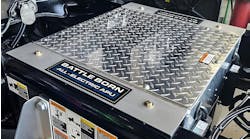The U.S. Environmental Protection Agency (EPA) and the Port Authority of New York & New Jersey (PANYNJ) unveiled a comprehensive agreement this week designed to help reduce pollution from the east coast’s busiest port.
The two states launched a $28 million truck replacement program, partially funded by $7 million from the American Recovery and Reinvestment Act, which will replace older trucks with vehicles that meet stricter pollution standards. It will be rolled out in two phases: first, a ban on pre-1994 trucks beginning Jan. 1, 2011 and then a ban on pre-2007 trucks beginning on Jan. 1, 2017.
This program is expected to replace about 600 model-year 1993 and older trucks with cleaner, 2004 and newer model models. Under the program, PANYNJ will cover 25% of a trucker’s costs for newer trucks. PANYNJ also plans to phase out additional older trucks serving the port as part of a broader strategy to reduce diesel emissions from their operations.
Part of a broader Clean Air Strategy, the replacement truck program involved the close collaboration of the EPA and the Port Authority, along with a consortium of state and local government agencies and industry, labor and environmental groups, including the New Jersey Dept. of Environmental Protection, New York State Dept. of Environmental Conservation, the City of New York Office of Long Term Planning and Sustainability, New York City Economic Development Corporation, New York Shipping Association and the cities of Bayonne, Elizabeth, Jersey City and Newark.
According to the EPA, there are more than three million truck trips to and from the Port of New York and New Jersey marine terminals each year, resulting in nearly 2,000 tons of nitrogen oxide and 55 tons of fine particle pollution. Nitrogen oxide is a precursor to smog, which can contribute to severe respiratory ailments. Likewise, fine particles are linked to lung and heart problems.
“Trucks and equipment used at ports are a significant source of pollution in the communities that surround them,” said Judith Enck, EPA Regional Administrator. “Efforts like the Port Authority’s new truck replacement program and the much broader sustainability agreement signed today will go a long way toward cutting this pollution and improving air quality and public health. Reducing dirty diesel emissions will protect the health of truck drivers and other workers at the port, along with the nearby community. I applaud the Port Authority for its leadership.”
Port Authority Chairman Anthony R. Coscia said, “The Clean Truck Program is the latest in our efforts to achieve cleaner air at and around our port. On top of our other investments - including $600 million to build on-dock rail and $60 million to acquire and preserve environmentally sensitive property - we believe this program will help build on our legacy as good environmental stewards."
The Port Authority of New York and New Jersey is not the first to roll out a truck replacement program. Earlier this year, the South Coast Air Quality Management District (SCAQMD) of California announced two separate vehicle replacement grant programs totaling more than $37 million. In addition to $16 million in state and federal funds to be spent on qualifying alternative fuel trucks, there is another $21.4 million available under the Proposition 1B Goods Movement Program, including $17.45 million for non-drayage trucks.


